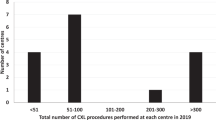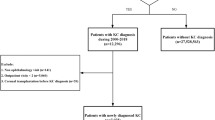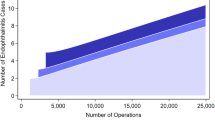Abstract
Background
Recurrent corneal erosion syndrome (RCES) is caused by repeated episodes of corneal epithelial breakdown due to improper adherence of the corneal epithelium to the underlying basement membrane. The most common aetiologies are corneal dystrophy or previous superficial ocular trauma. The incidence and prevalence of the condition is currently unknown. This study aimed to determine the incidence and prevalence of RCES within the London population over a 5-year period in order to better inform clinicians and evaluate how this condition affects ophthalmic service provision.
Methods
A retrospective cohort study over a 5-year period reviewed 487,690 emergency room patient attendances at Moorfields Eye Hospital (MEH) London between 1 January 2015 and 31 December 2019. MEH caters for a local population comprising of around ten regional clinical commissioning groups (CCGs). The data for this study were collected using OpenEyesTM electronic medical records including demographics and comorbidities. The CCGs encompass 41% (3,689,000) of London’s total 8,980,000 inhabitants. Using these data the crude incidence and prevalence rates of disease were estimated with results reported per 100,000 population.
Results
Out of 330,684 patients, 3623 patients were given a new diagnosis of RCES by the emergency ophthalmology services, and from these, 1056 patients attended outpatient follow-up. The crude annual incidence of RCES was estimated at 25.4 per 100,000, with a crude prevalence rate of 0.96%. There was no statistical difference in annual incidence across the 5-year period.
Conclusions
The period prevalence of 0.96% shows that RCES is not uncommon. There was also a stable annual incidence over the 5-year period, showing no changing trend over the study period. However, identifying the true incidence and period prevalence is a challenging task, as minor cases may heal prior to examination by an ophthalmologist. It is highly likely that RCES is underdiagnosed and therefore underreported.
This is a preview of subscription content, access via your institution
Access options
Subscribe to this journal
Receive 18 print issues and online access
$259.00 per year
only $14.39 per issue
Buy this article
- Purchase on Springer Link
- Instant access to full article PDF
Prices may be subject to local taxes which are calculated during checkout
Similar content being viewed by others
Data availability
The data that support the findings of this study are available from the corresponding author upon reasonable request.
References
Brown N, Bron A. Recurrent erosion of the cornea. Br J Ophthalmol. 1976;60:84–96.
Reidy JJ, Paulus MP, Gona S. Recurrent erosions of the cornea: epidemiology and treatment. Cornea. 2000;19:767–71.
Heyworth P, Morlet N, Rayner S, Hykin P, Dart J. Natural history of recurrent erosion syndrome—a 4 year review of 117 patients. Br J Ophthalmol. 1998;82:26–8.
Wood T. Recurrent erosion. Trans Am Ophthalmol Soc. 1984;82:850–98.
Bernauer W, De Cock R, Dart JK. Phototherapeutic keratectomy in recurrent corneal erosions refractory to other forms of treatment. Eye. 1996;10:561–4.
Miller DD, Hasan SA, Simmons NL, Stewart MW. Recurrent corneal erosion: a comprehensive review. Clin Ophthalmol. 2019;13:325–35.
Watson SL, Leung V. Interventions for recurrent corneal erosions. Cochrane Database Syst Rev. 2018;2018:1311.
Gupta N, Vashist P, Tandon R, Gupta SK, Dwivedi S, Mani K. Prevalence of corneal diseases in the rural Indian population: the Corneal Opacity Rural Epidemiological (CORE) study. Br J Ophthalmol. 2015;99:147–52.
Tran TM, Duong H, Bonnet C, Kashanchi A, Buckshey A, Aldave AJ. Corneal blindness in Asia: a systematic review and meta-analysis to identify challenges and opportunities. Cornea. 2020;39:1196–205.
Jan R-L, Tai MC, Ho CH, Chu CC, Wang JJ, Tseng SH, et al. Risk of recurrent corneal erosion in patients with diabetes mellitus in Taiwan: a population-based cohort study. BMJ Open. 2020;10:e035933.
CQC, Moorfields Eye Hospital CQC Report. 2019.
Williams N, Hardy BM, Tarrant S, Enninghorst N, Attia J, Oldmeadow C, et al. Changes in hip fracture incidence, mortality and length of stay over the last decade in an Australian major trauma centre. Arch Osteoporos. 2013;8:1–5.
Moffatt CJ, Franks PJ, Doherty DC, Martin R, Blewett R, Ross F. Prevalence of leg ulceration in a London population. QJM. 2004;97:431–7.
Author information
Authors and Affiliations
Contributions
SB was responsible for overall trial co-ordination and manuscript preparation. ASA was responsible for data analysis. PYS and MAI undertook data collection. RH, SA and AS undertook manuscript preparation.
Corresponding author
Ethics declarations
Competing interests
The authors declare no competing interests.
Additional information
Publisher’s note Springer Nature remains neutral with regard to jurisdictional claims in published maps and institutional affiliations.
Rights and permissions
Springer Nature or its licensor (e.g. a society or other partner) holds exclusive rights to this article under a publishing agreement with the author(s) or other rightsholder(s); author self-archiving of the accepted manuscript version of this article is solely governed by the terms of such publishing agreement and applicable law.
About this article
Cite this article
Balal, S., Ansari, A.S., Sim, P.Y. et al. The incidence and prevalence of recurrent corneal erosion syndrome in London, UK. Eye 37, 3213–3216 (2023). https://doi.org/10.1038/s41433-023-02490-3
Received:
Revised:
Accepted:
Published:
Issue Date:
DOI: https://doi.org/10.1038/s41433-023-02490-3
This article is cited by
-
Efficacy of topical insulin for recurrent epithelial corneal erosions
Irish Journal of Medical Science (1971 -) (2023)



